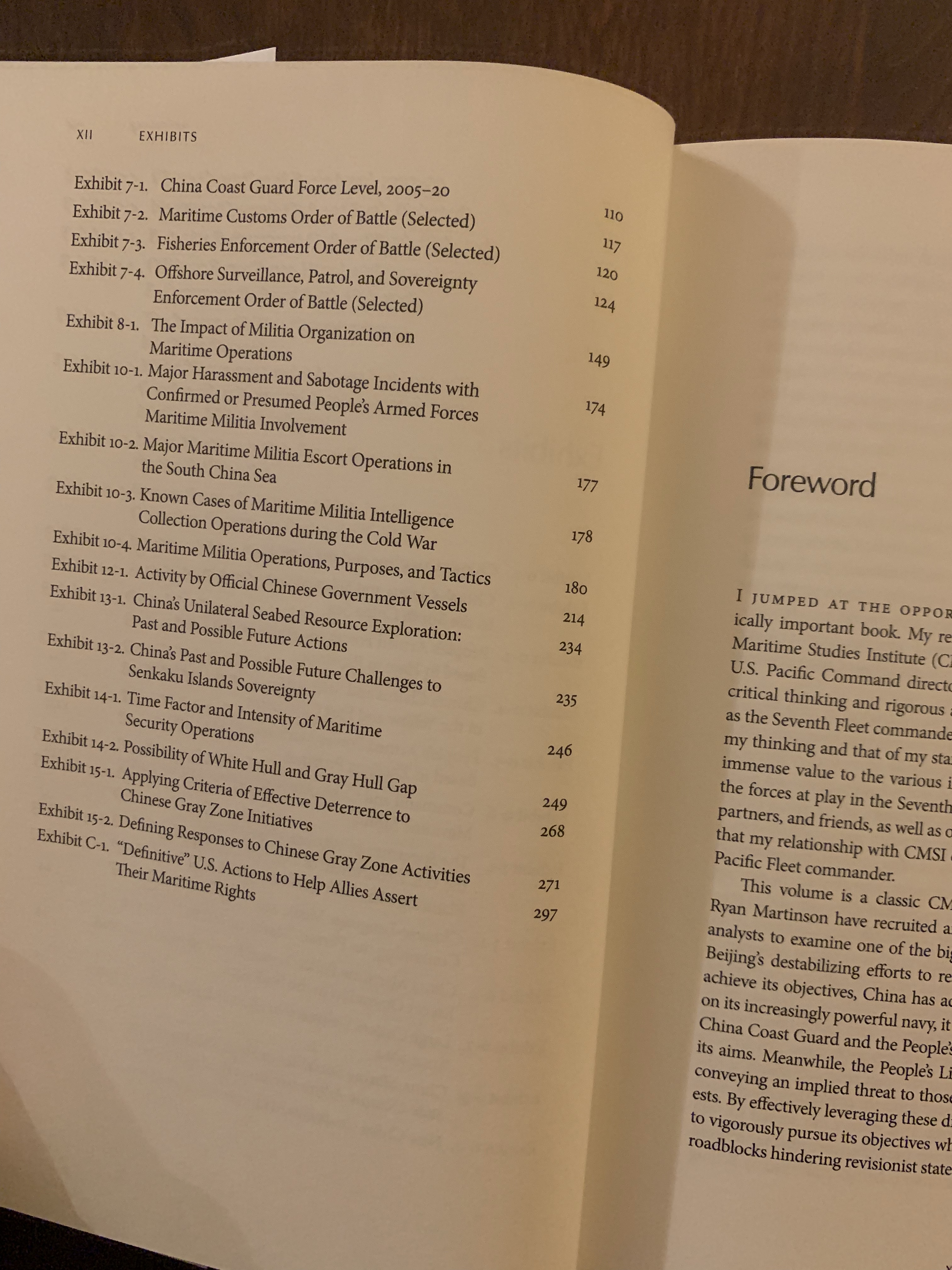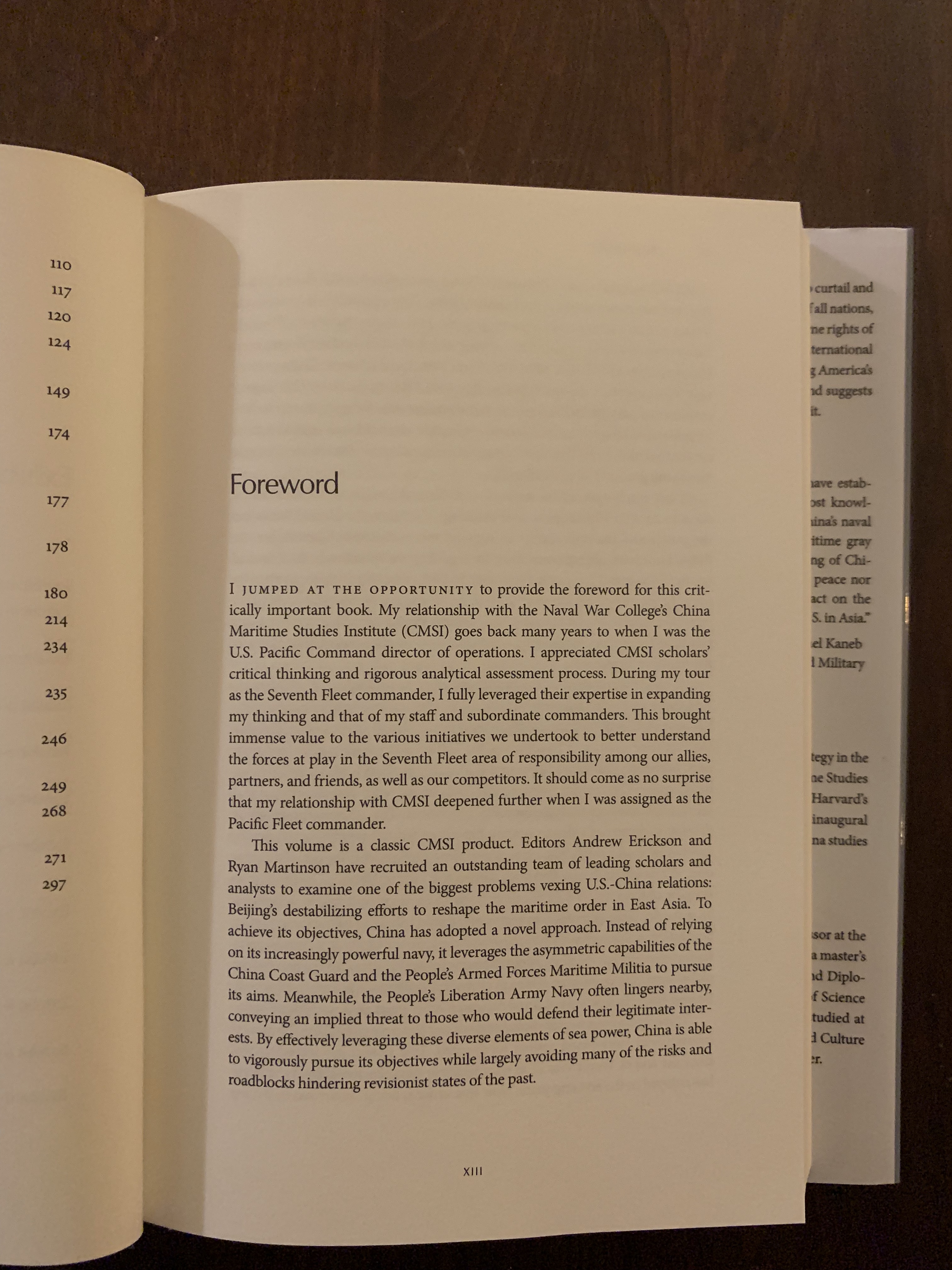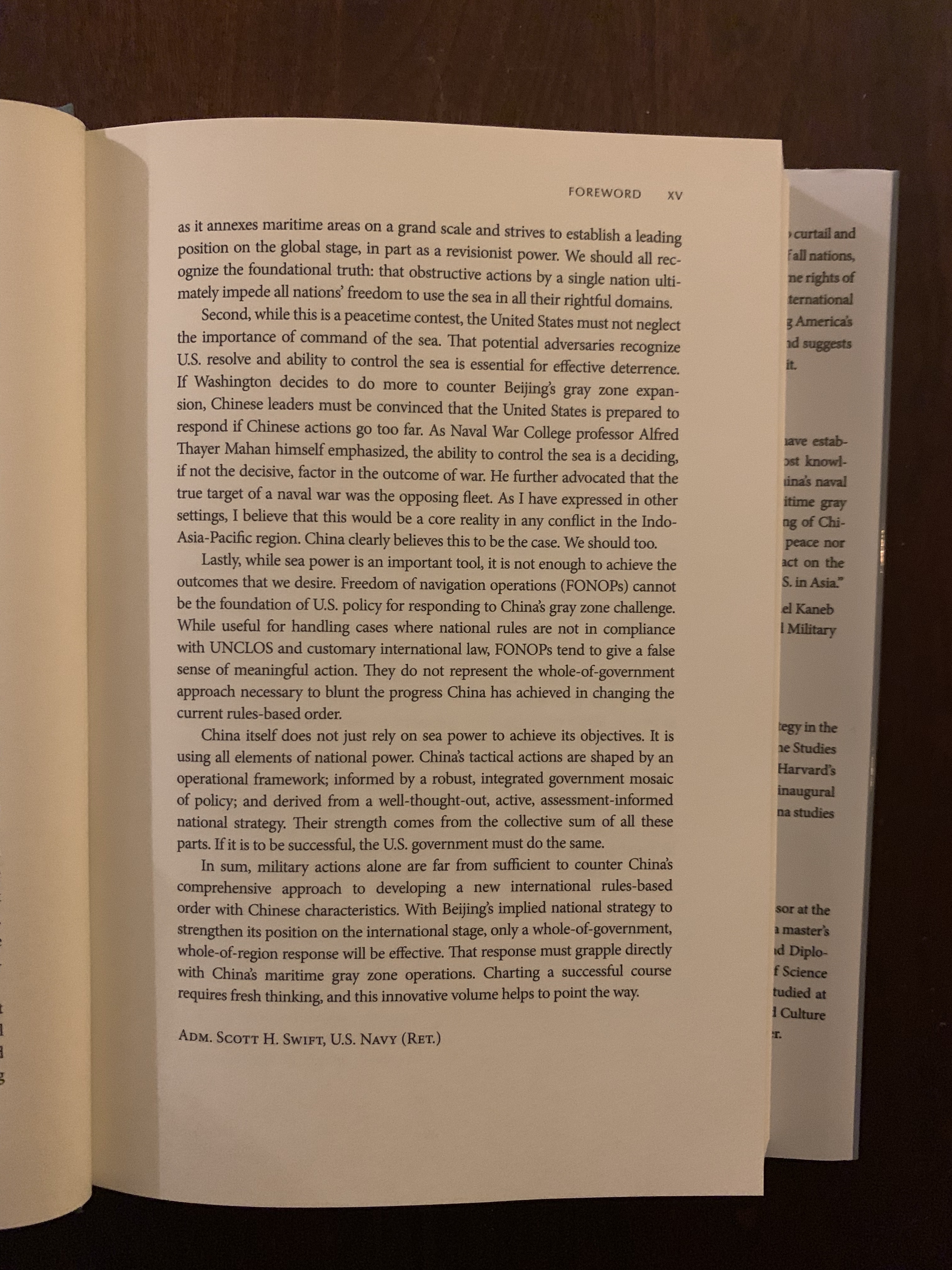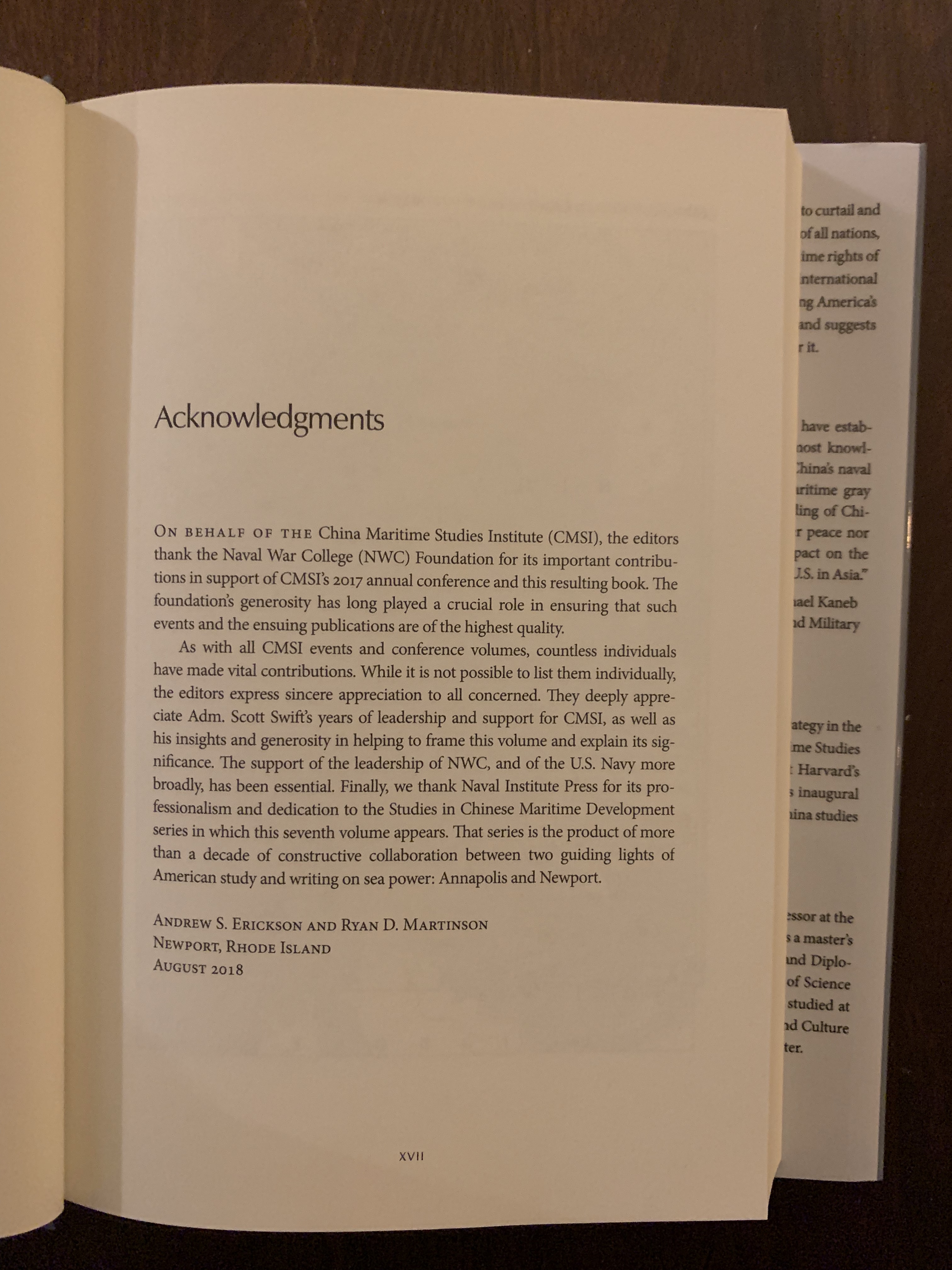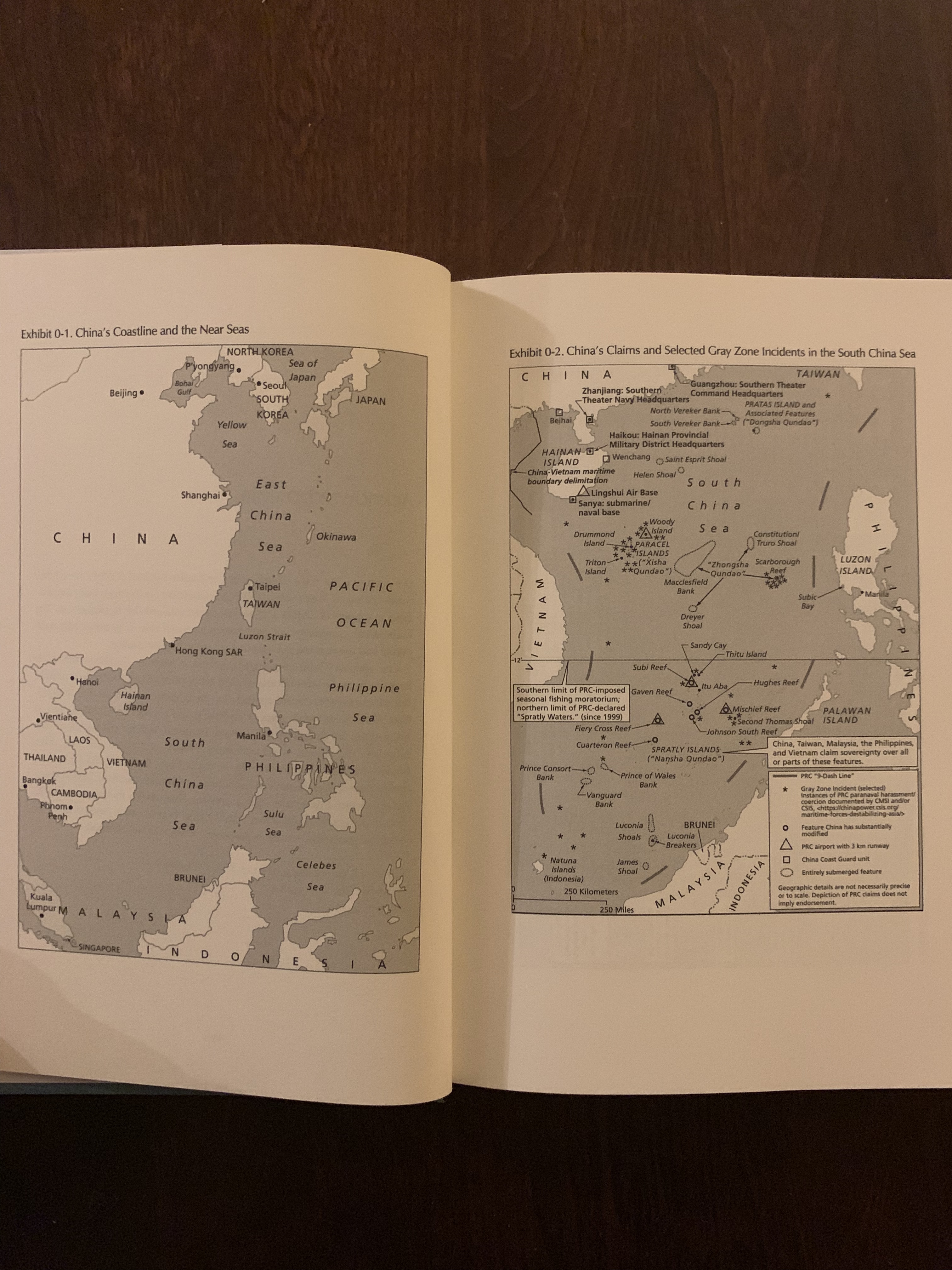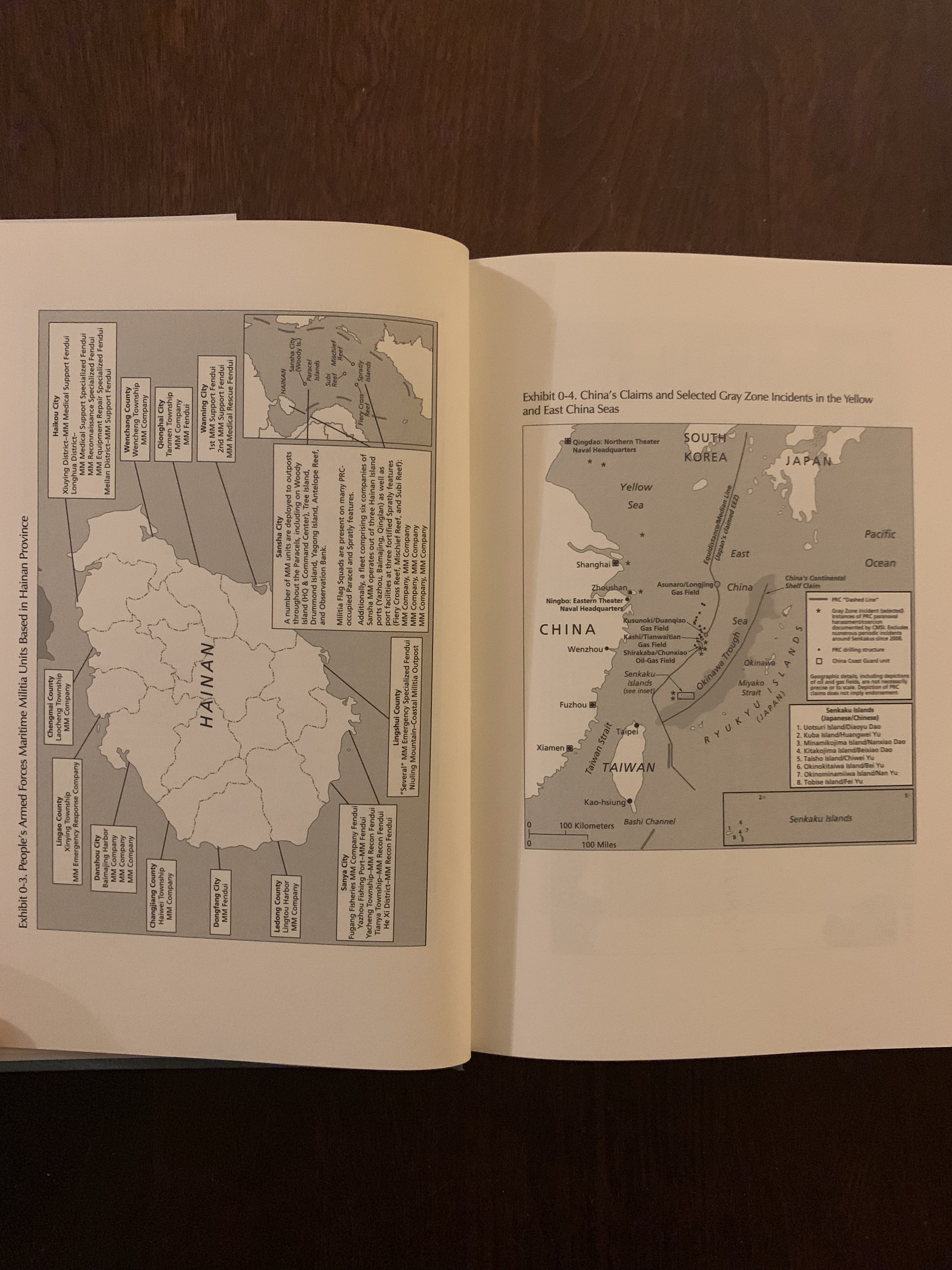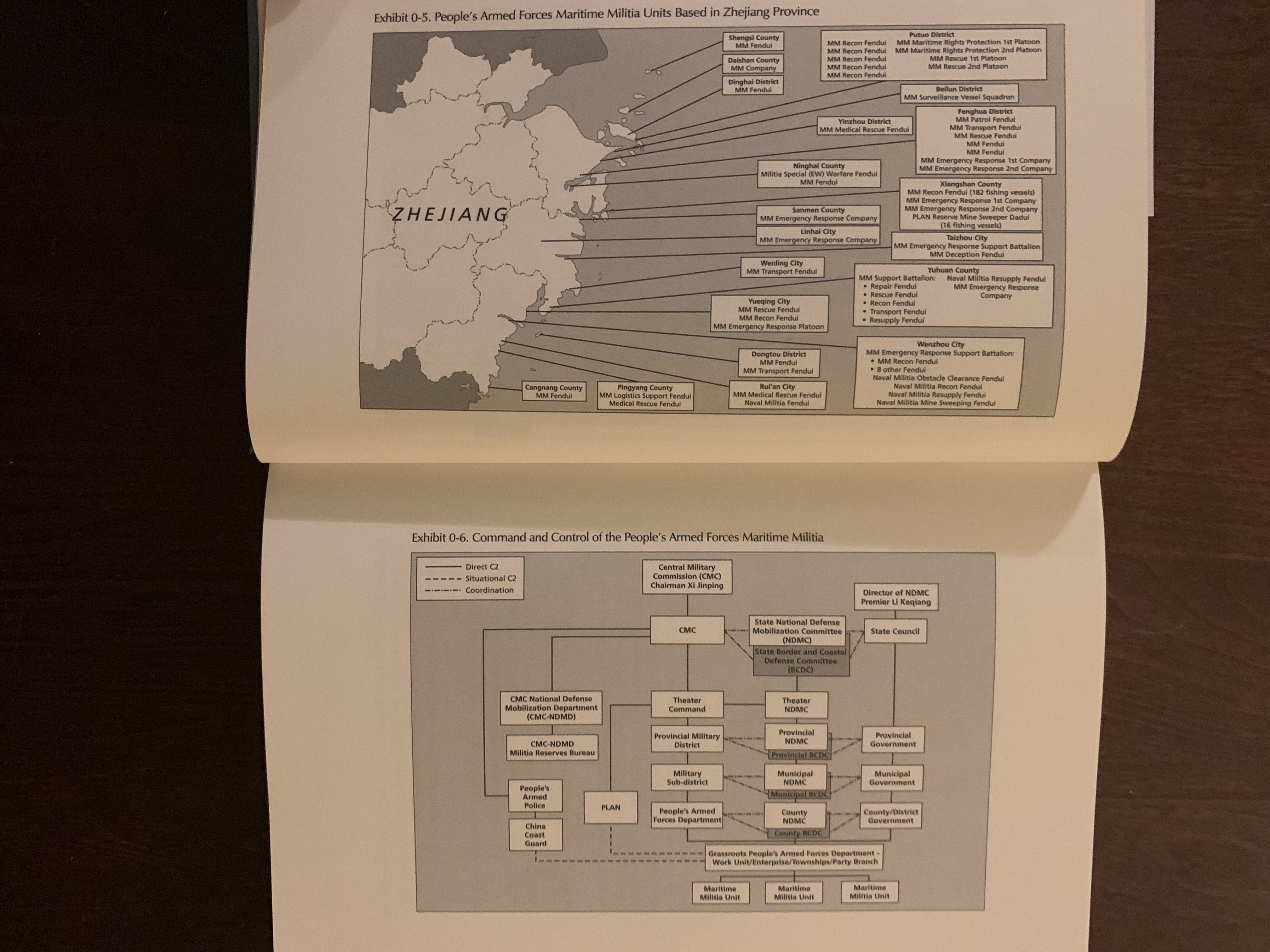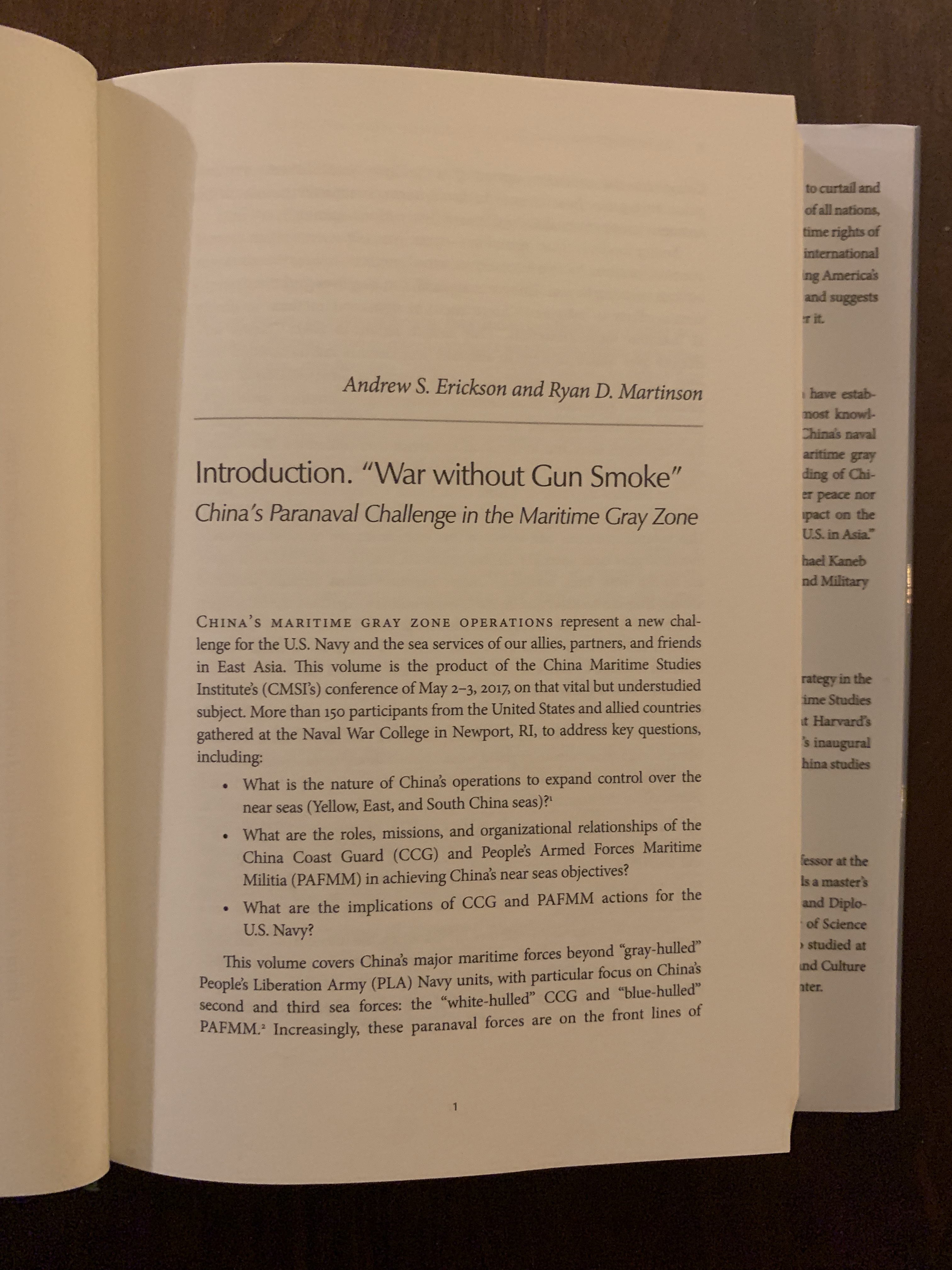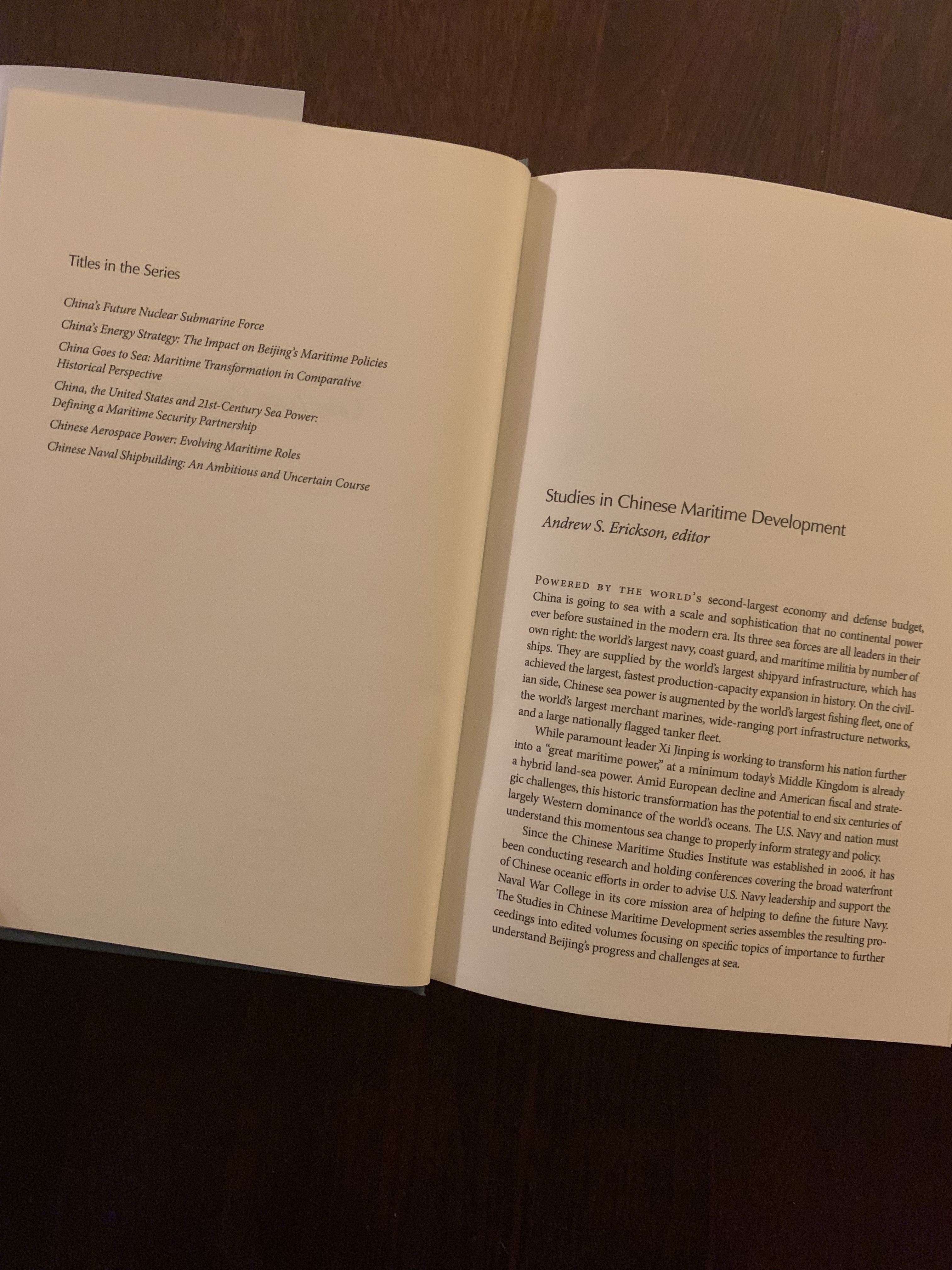Andrew Erickson and Ryan Martinson on China and the Maritime Gray Zone
Prashanth Parameswaran, “Andrew Erickson and Ryan Martinson on China and the Maritime Gray Zone,” The Diplomat, 14 May 2019.
How China thinks about and acts in the maritime gray zone, and what that means for the region’s future.
Over the past few years, as China has continued its expansion in the maritime domain, scholars and practitioners alike have honed in on the subject of how Beijing operates in the so-called “gray zone” between war and peace, staying below the threshold of armed conflict to secure gains while not provoking military responses by others, including the United States. Understanding the dynamics of this has important implications not only for particular maritime spaces, such as the East China Sea and the South China Sea, but also for broader issues such as the management of U.S.-China competition and wider regional peace and stability.
The Diplomat’s senior editor, Prashanth Parameswaran, recently spoke to Andrew Erickson and Ryan Martinson, both affiliated with the U.S. Naval War College’s China Maritime Studies Institute, about how China thinks about and acts in the maritime gray zone and what that might mean for the region’s future. The discussion was framed around the release of a new edited volume by the authors in March entitled China’s Maritime Gray Zone Operations.
One of the core contributions of the book is providing a detailed and systematic understanding of how China itself thinks about the maritime gray zone – both on its own terms as well as how it related to broader Chinese foreign and defense policy – with a detailed use of Chinese sources. What are some of the key takeaways about how China thinks about the maritime gray zone in particular, in terms of how it is defined as well as the objectives and key components of China’s approach? And what would you flag as some of the areas of similarity and difference with respect to how others may think of these challenges and talk about them?
China is much more transparent in Chinese. And, particularly in native-language sources, Chinese policymakers are very clear about the fact that their long-term goal is to exercise “administrative control” over all of the 3 million square kilometers of Chinese-claimed maritime space. This includes all of the Bohai Gulf, large sections of the Yellow Sea and East China Sea, and all of the area within the nine-dash line in the South China Sea. Many Western analysts assume that China has more abstract aims, like discrediting the international legal order. This may happen anyway, as a byproduct of their actions, but the most compelling evidence suggests that Beijing sees strategic, economic, and symbolic value in controlling as much space as possible within the First Island Chain.
Chinese leaders don’t use the term “gray zone” to describe their approach to asserting control over this space. For at least a decade, they have conceived of their policy as a balancing act. On the one hand, they feel the need to defend and advance China’s claims. They call these actions “maritime rights protection.” On the other hand, they want to avoid severely harming their relations with other states. Regional stability, after all, is vital for sustaining China’s economic development — which remains the core of China’s grand strategy. Using paranaval forces like the coast guard and the militia allows them to find an optimal balance between “rights protection” and “stability maintenance.” Paranaval forces are much less provocative than gray-hulled warships. The Chinese coast guard operates on the pretext of routine law enforcement, and militia often pretend to be fishermen. Yet both forces can be used to pursue traditional military objectives of controlling space. … … …
INFORMATION ON EDITED VOLUME
Andrew S. Erickson and Ryan D. Martinson, China’s Maritime Gray Zone Operations (Annapolis, MD: Naval Institute Press, 2019).
As with the previous six volumes in our “Studies in Chinese Maritime Development” series, an Amazon Kindle edition will be available.
Eventually, there will also be an authorized Chinese-language translation through Ocean Press, China’s leading maritime publisher.
- Andrew S. Erickson and Ryan D. Martinson, “Introduction: ‘War Without Gun Smoke’—China’s Paranaval Challenge in the Maritime Gray Zone,” 1-11.
- Joshua Hickey, Andrew S. Erickson, and Henry Holst, “China Maritime Law Enforcement Surface Platforms: Order of Battle, Capabilities, and Trends,” 108-132.
- Andrew S. Erickson and Ryan D. Martinson, “Conclusion: Options for the Definitive Use of U.S. Sea Power in the Gray Zone,” 291-301.
China’s maritime “gray zone” operations represent a new challenge for the U.S. Navy and the sea services of our allies, partners, and friends in maritime East Asia. There, Beijing is waging operations conducted to alter the status quo without resorting to war, an approach that some Chinese sources term “War without Gun Smoke” (一场没有硝烟的战争). Already winning in important areas, China could gain far more if left unchecked. One of China’s greatest advantages thus far has been foreign difficulty in understanding the situation, let alone determining an effective response. With contributions from some of the world’s leading subject matter experts, this volume aims to close that gap by explaining the forces and doctrines driving China’s paranaval expansion.
The book therefore covers in-depth China’s major maritime forces beyond core gray-hulled Navy units, with particular focus on China’s second and third sea forces: the “white-hulled” Coast Guard and “blue-hulled” Maritime Militia. Increasingly, these paranaval forces are on the frontlines of China’s seaward expansion, operating in the “gray zone” between war and peace: where the greatest action is. Beijing works constantly in peacetime (and possibly in crises short of major combat operations with the United States) to “win without fighting” and thereby to further its unresolved land feature and maritime claims in the Near Seas (Yellow, East, and South China Seas). There is an urgent need for greater understanding of this vital yet under-explored topic: this book points the way.

Volume 7 in Studies in Chinese Maritime Development series
March 2019 | 336 pp. | 6 x 9 | China and the Asia-Pacific
Maps | Hardcover
ASIN: 1591146933
ISBN-13: 978-1591146933
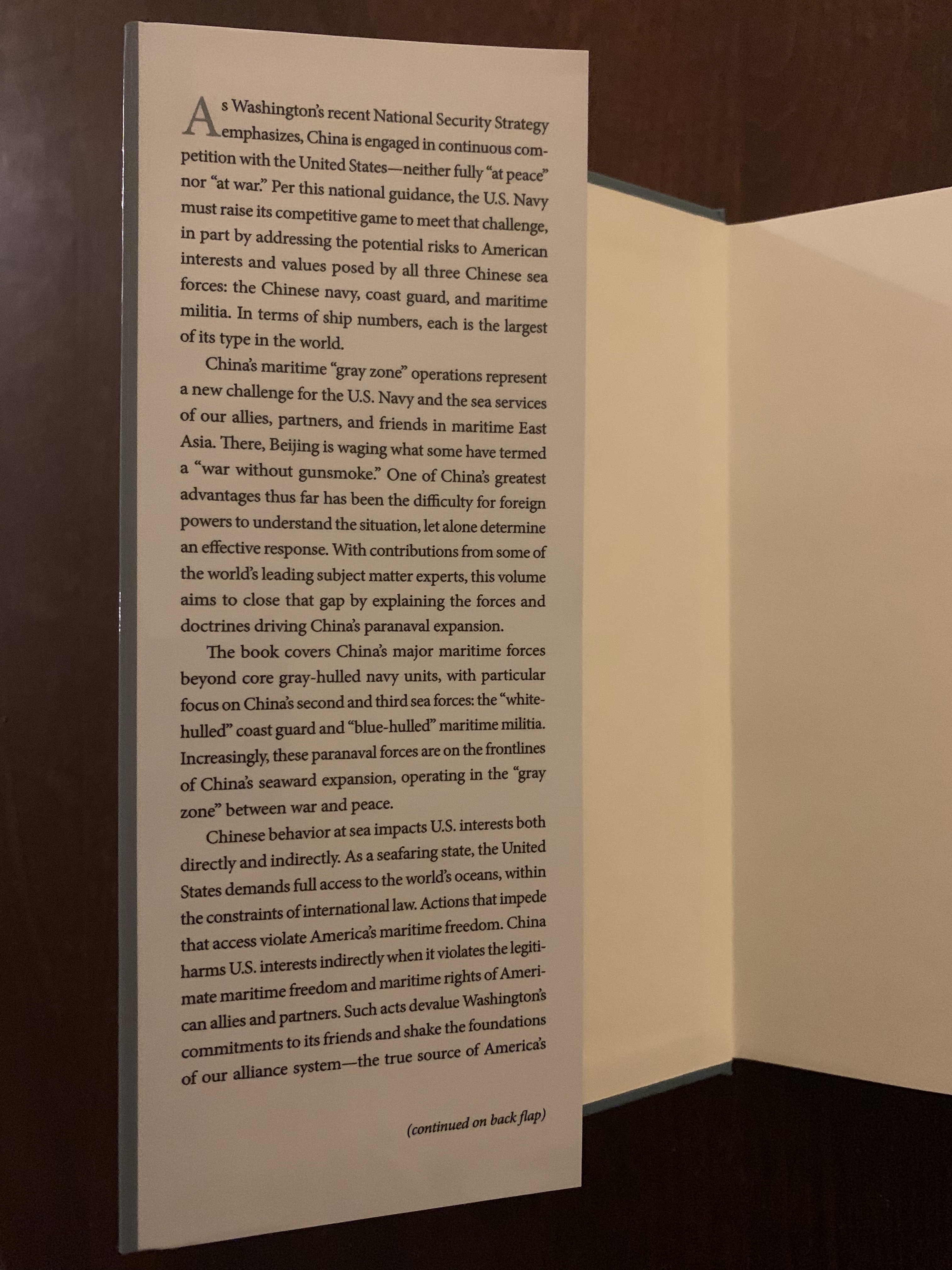
BOOK DESCRIPTION
As Washington’s new National Security Strategy emphasizes, China is engaged in continuous competition with the United States–neither fully “at peace” nor “at war.” Per this national guidance, the U.S. Navy must raise its competitive game to meet that challenge, in part by addressing the potential risks to American interests and values posed by all three Chinese sea forces: the Navy, Coast Guard, and Maritime Militia. In terms of ship numbers, each is the largest of its type in the world.
China’s maritime “gray zone” operations represent a new challenge for the U.S. Navy and the sea services of our allies, partners, and friends in maritime East Asia. There, Beijing is waging what some Chinese sources term a “war without gunsmoke.” One of China’s greatest advantages thus far is the difficulty for foreign powers to understand the situation, let alone determine an effective response. With contributions from some of the world’s leading subject matter experts, this volume aims to close that gap by explaining the forces and doctrines driving China’s paranaval expansion.
This book covers China’s major maritime forces beyond core gray-hulled Navy units, with particular focus on China’s second and third sea forces: the “white-hulled” Coast Guard and “blue-hulled” Maritime Militia. Increasingly, these paranaval forces are on the frontlines of China’s seaward expansion, operating in the “gray zone” between war and peace.
Chinese behavior at sea harms U.S. interests both directly and indirectly. As a seafaring state, America demands maximal access to the world’s oceans within the constraints of international law. Actions that impede that access violate America’s maritime freedom. China harms U.S. interests indirectly when it violates the legitimate maritime freedom and maritime rights of its allies and partners. Such acts devalue Washington’s commitments to its friends and shake the foundations of our alliance system–the true source of America’s global influence. Moreover, China’s efforts to curtail and infringe upon both the maritime freedom of all nations including the United States and the maritime rights of its neighbors undermines the rules-based international order. This volume concludes by examining America’s response to Beiing’s gray zone coercion and suggests what U.S. policymakers can do to counter it.
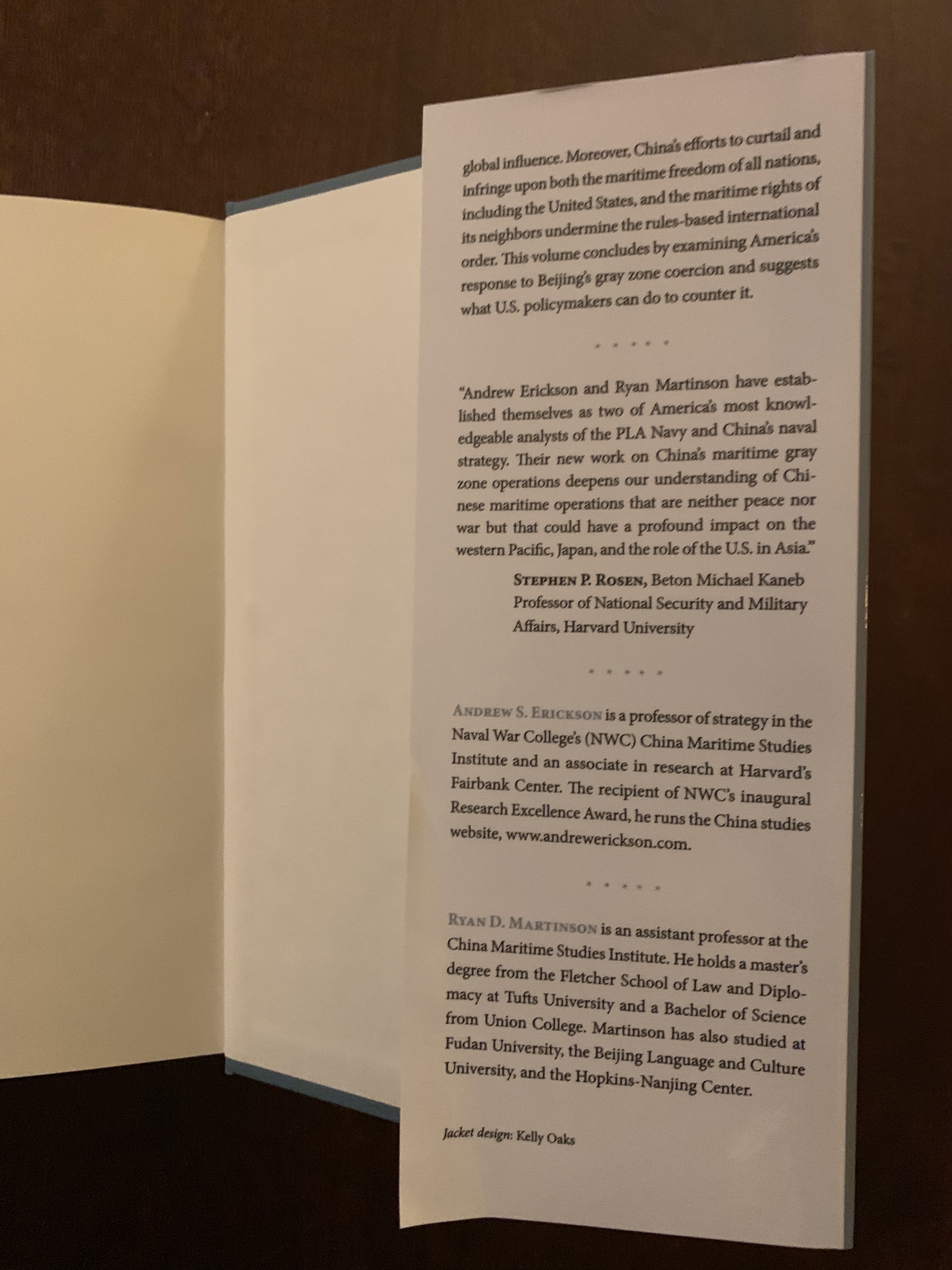
BLURBS
“How can the lightly armed white-hulled and blue-hulled ships of China’s coast guard and maritime militia defeat the heavily armed gray-hulled navies of the U.S. and its allies? Nowhere is this urgent question explored more exhaustively than in this incisive book. It should serve as a wake-up call for the American military.”
—J. William Middendorf, former Secretary of the Navy
“Many fret and opine about China’s gray zone behavior and strategy, yet few know and understand what is at play and in play in that space between peace and war. China’s Maritime Gray Zone Operations is a timely and extraordinarily valuable resource for both new and experienced operators and policymakers who will navigate the gray zone challenge in the years ahead.”
—Admiral Gary Roughead, U.S. Navy (Ret.), Hoover Institution Fellow and former Chief of Naval Operations
“Who needs the CIA? Maritime competition represents the front lines in the struggle for influence between China and the United States. Gray hulls are not the only way Beijing tries to shift the balance. China’s Maritime Gray Zone Operations provides as comprehensive an assessment of the challenge as one might expect from Langley.”
—James Jay Carafano, Ph.D., The Heritage Foundation
“Andrew Erickson and Ryan Martinson have established themselves as two of America’s most knowledgeable analysts of the PLA Navy and China’s naval strategy. Their new work on China’s maritime gray zone operations deepens our understanding of Chinese maritime operations that are neither peace nor war but that could have a profound impact on the western Pacific, Japan, and the role of the U.S. in Asia.”
—Stephen P. Rosen, Beton Michael Kaneb Professor of National Security and Military Affairs, Harvard University
“An informative and striking book, which provides many eye-opening thoughts on China’s crafty and worrisome ‘gray zone’ strategy. A great focus is placed on practical countermeasures…. A good guideline for the planning and operations of frontline sailors.”
—Vice Admiral Yoji Koda, Japan Maritime Self-Defense Force (JMSDF) (Ret.) and former Commander-in-Chief, JMSDF Fleet
“This is an excellent account of how China is using its navy, coast guard, and maritime militia to expand its control and use of adjoining sea areas and exclude others from their use of sea areas legally recognized.”
—Andrew W. Marshall, retired, former Director of Net Assessment, Department of Defense
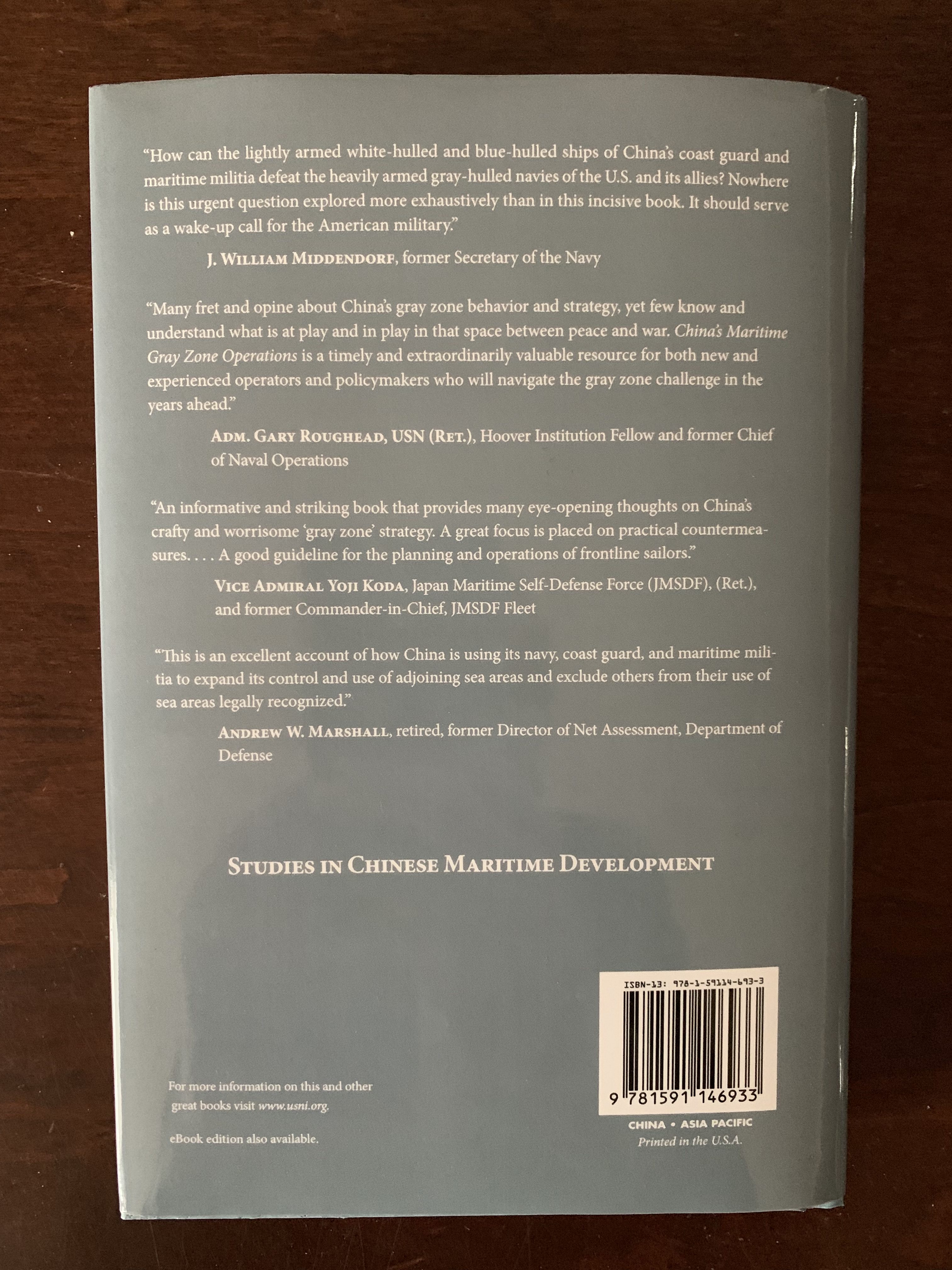
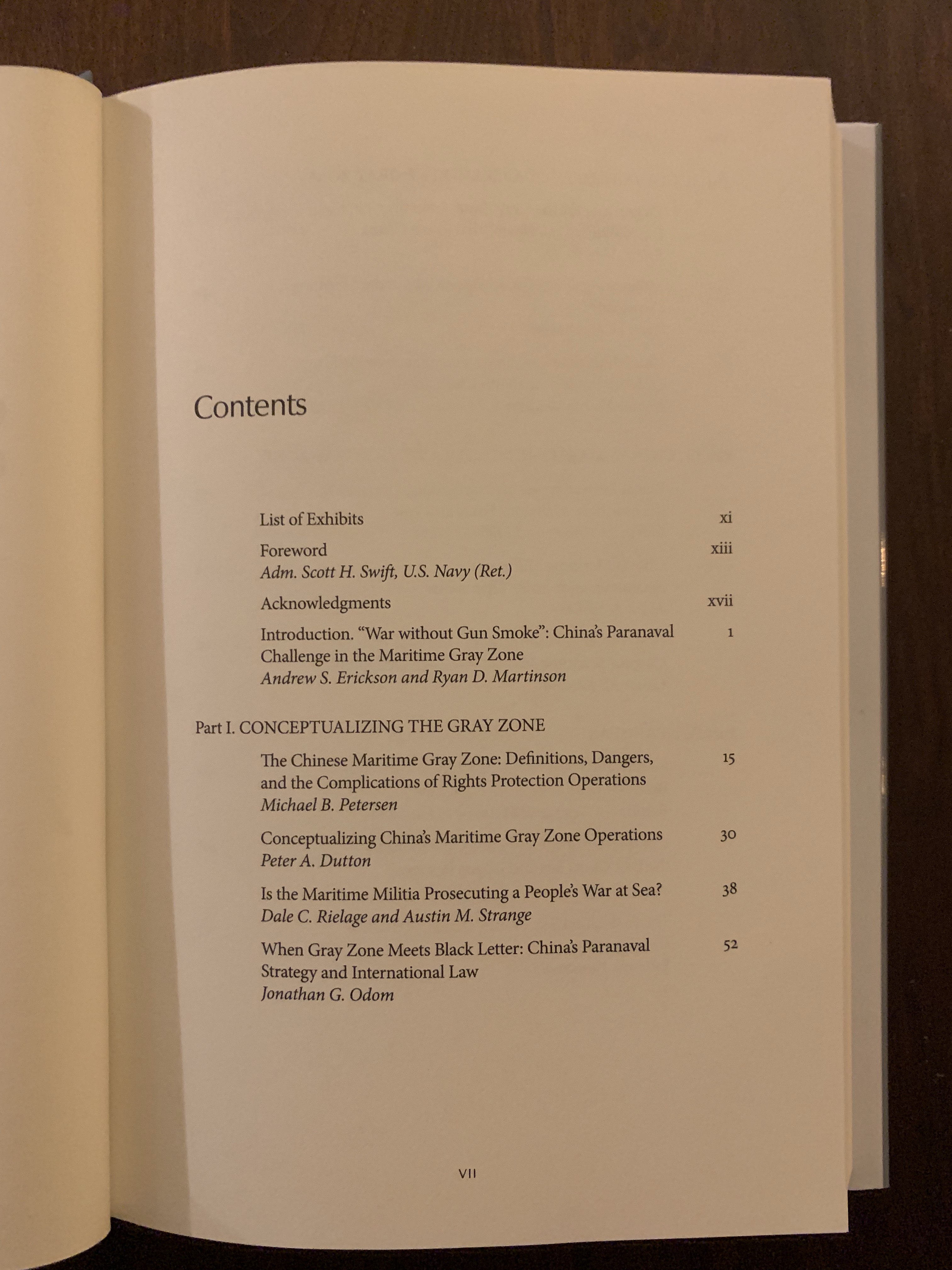
REVIEWS
“the book provides a cornerstone of what is happening now in addition to where things are likely headed. …certain to enlighten you.”
—Virtual Mirage, 6 April 2019.
“… a first rate piece of work. …the discussions of the book could be seen as a historic look at a phase of Chinese maritime power and the evolving approach to strategic engagement in the region and beyond. … I would highly recommend reading this important book and thinking through what it teaches us, or challenges us to think about in terms of the much broader spectrum of crisis management we are facing.”
—Robbin Laird, Defense Info, 26 March 2019.
ABOUT THE EDITORS
Andrew S. Erickson is professor of strategy in the Naval War College (NWC)’s China Maritime Studies Institute (CMSI) and an associate in research at Harvard’s Fairbank Center. The recipient of NWC’s inaugural Research Excellence Award, he runs the China studies websitewww.andrewerickson.com.
Ryan D. Martinson is an assistant professor at CMSI. He holds a master’s degree from the Fletcher School of Law and Diplomacy at Tufts University and a bachelor’s of science from Union College. Martinson has also studied at Fudan University, the Beijing Language and Culture University, and the Hopkins-Nanjing Center.
ABOUT THE AUTHORS
Morgan Clemens is a Research Analyst at SOS International LLC.
Peter A. Dutton, a retired U.S. Navy Commander and judge advocate, is Professor and Director at CMSI.
Matthew Funaiole is a fellow with the China Power Project at the Center for Strategic and International Studies (CSIS).
Bonnie S. Glaser is senior adviser for Asia and director of CSIS’s China Power Project.
Joshua Hickey is a senior analyst for the Department of the Navy with over fifteen years’ subject matter experience.
Henry Holst is a junior analyst for the Department of the Navy.
Conor M. Kennedy is a research associate at CMSI.
Adam P. Liff is an assistant professor at Indiana University’s School of Global and International Studies and an associate in research at Harvard’s Reischauer Institute of Japanese Studies.
Michael Mazarr is a senior political scientist and associate director of the strategy and doctrine program at the RAND Corporation’s Arroyo Center.
Barney Moreland, a retired Captain who served as the first U.S. Coast Guard Liaison Officer in Beijing, is the Senior Intelligence Analyst at U.S. Pacific Fleet Headquarters.
Lyle J. Morris is a senior policy analyst at RAND.
Cdr. Jonathan G. Odom, USN, is a judge advocate and military professor at the Asia-Pacific Center for Security Studies.
Michael B. Petersen is the founding director Russia Maritime Studies Institute and an associate professor in the Center for Naval Warfare Studies at NWC.
Capt. Dale C. Rielage, USN, is Director for Intelligence and Information Operations, U.S. Pacific Fleet.
Mark A. Stokes, a retired U.S. Air Force Lieutenant Colonel, is Executive Director of the Project 2049 Institute.
Austin M. Strange is a Ph.D. candidate in Harvard University’s Government Department.
Admiral Tomohisa Takei, Japan Maritime Self-Defense Force (JMSDF) (Ret.) concluded his thirty-seven-year naval career as the JMSDF’s 32nd Chief of Staff, and is now a professor and distinguished international fellow at NWC.
Michael Weber a foreign affairs analyst and Presidential Management Fellow at the Congressional Research Service.
Capt. Katsuya Yamamoto, JMSDF, who served as a Defense/Naval Attaché in Beijing, is a liaison officer and international military professor at NWC.
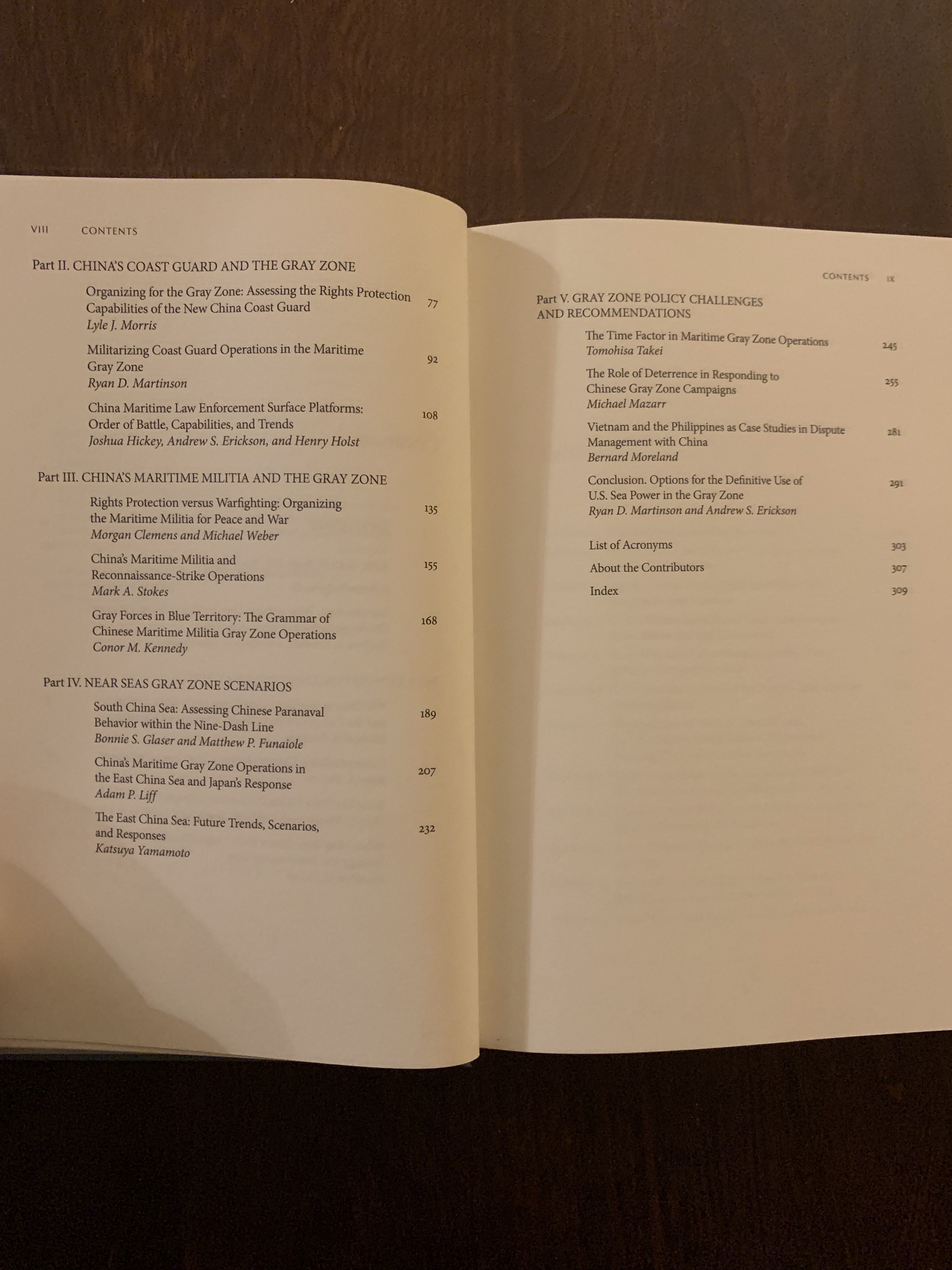
Previous Titles in the Series
China’s Future Nuclear Submarine Force
China’s Energy Strategy: The Impact on Beijing’s Maritime Policies
China Goes to Sea: Maritime Transformation in Comparative Historical Perspective
China, the United States and 21st-Century Sea Power: Defining a Maritime Security Partnership
Chinese Aerospace Power: Evolving Maritime Roles
Chinese Naval Shipbuilding: An Ambitious and Uncertain Course
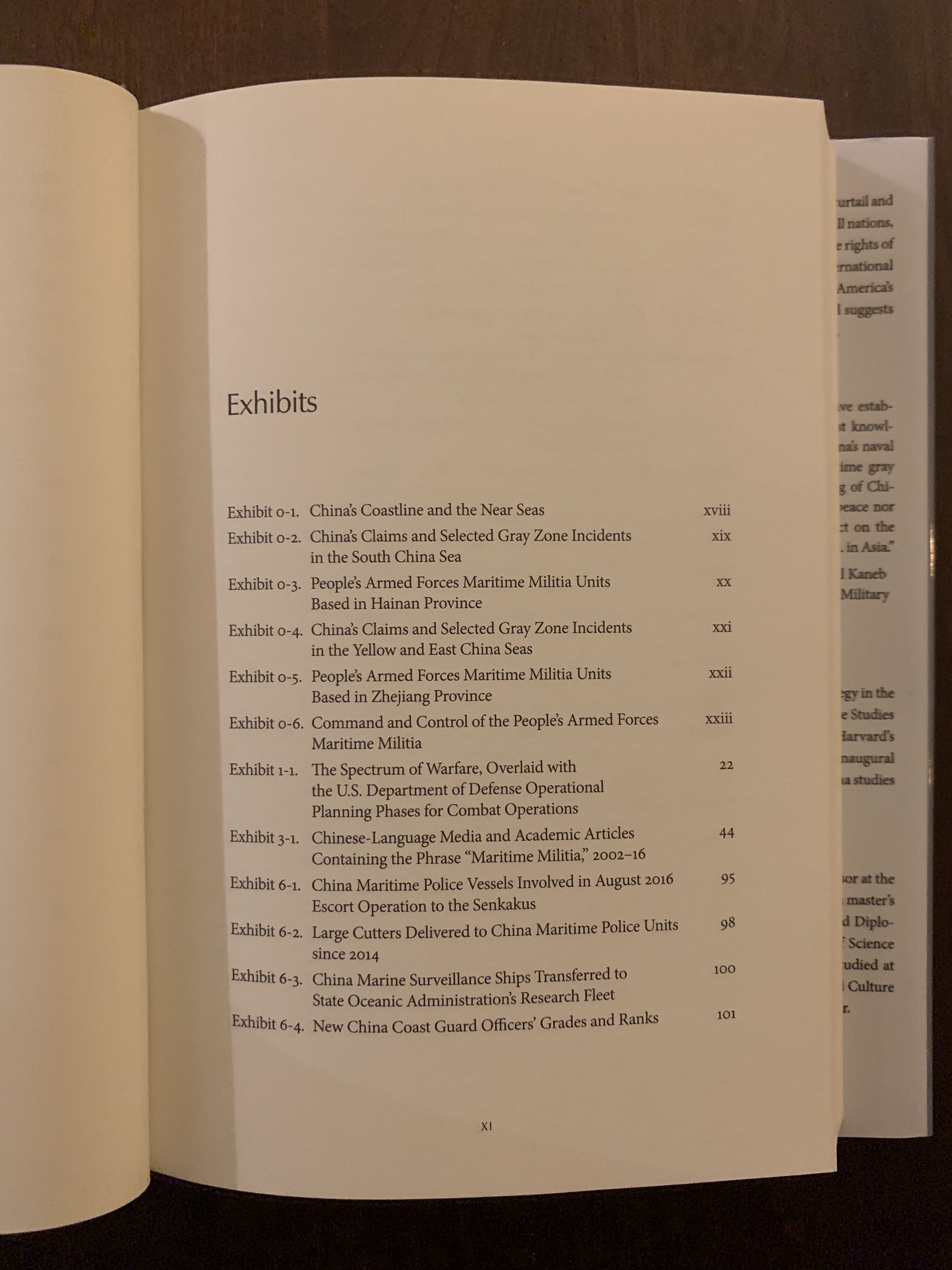
RELATED READING
INTERVIEW
Dmitry Filipoff, “Andrew S. Erickson and Ryan D. Martinson Discuss China’s Maritime Gray Zone Operations,” Center for International Maritime Security (CIMSEC), 11 March 2019.
- Republished as “Interview: China’s Maritime ‘Gray Zone’ Operations,” The Maritime Executive, 2019.
On March 15th, the Naval Institute Press will publish China’s Maritime Gray Zone Operations, a volume edited by professors Andrew S. Erickson and Ryan D. Martinson from the Naval War College’s China Maritime Studies Institute. CIMSEC recently reached out to Erickson and Martinson about their latest work.
Q: What was the genesis of your book?
Erickson: In the last decade or so, China has dramatically expanded its control and influence over strategically important parts of maritime East Asia. It has done so despite opposition from regional states, including the United States, and without firing a shot. Others have examined this topic, but we found that much of the public analysis and discussion was not grounded in solid mastery of the available Chinese sources—even though China tends to be much more transparent in Chinese. We also recognized a general lack of understanding about the two organizations on the front lines of Beijing’s seaward expansion: the China Coast Guard (CCG) and the People’s Armed Forces Maritime Militia (PAFMM). This volume grew out of a conference we held in Newport in May 2017 to address some of these issues. It contains contributions from world-leading subject matter experts, with a wide range of commercial, technical, government, and scholarly experience and expertise. We’re honored to receive endorsements from top leaders in sea power, strategy, and policy: former Chief of Naval Operations Admiral Gary Roughead, former Secretary of the Navy J. William Middendorf, Harvard Professor Stephen Rosen, former Japan Maritime Self-Defense Force Fleet Commander-in-Chief Vice Admiral Yoji Koda, Dr. James Carafano of the Heritage Foundation, and former Pentagon Director of Net Assessment Andrew Marshall.
Q: The title of your book is China’s Maritime Gray Zone Operations. How does the term “gray zone” apply here?
Martinson: We usually prefer to use Chinese concepts when talking about Chinese behavior, and Chinese strategist do not generally use the term “gray zone.” But we think that the concept nicely captures the essence of the Chinese approach. We were inspired by the important work done by RAND analyst Michael Mazarr, who contributed a chapter to the volume. In his view, gray zone strategies have three primary characteristics. They seek to alter the status quo. They do so gradually. And they employ “unconventional” elements of state power. Today, a large proportion of Chinese-claimed maritime space is controlled or contested by other countries. This is the status quo that Beijing seeks to alter. Its campaign to assert control over these areas has progressed over a number of years. Clearly, then, Chinese leaders are in no rush to achieve their objectives. And while China’s Navy plays a very important role in this strategy, it is not the chief protagonist.
Q: Who, then, are the chief actors?
Martinson: The CCG and the PAFMM perform the vast majority of Chinese maritime gray zone operations. Chinese strategists and spokespeople frame their actions as righteous efforts to protect China’s “maritime rights and interests.” The CCG uses law enforcement as a pretext for activities to assert Beijing’s prerogatives in disputed maritime space. PAFMM personnel are often disguised as civilian mariners, especially fishermen. Most do fish, at least some of the time. But they can be activated to conduct rights protection operations. And a new elite subcomponent is paid handsomely to engage in sovereignty promotion missions fulltime without fishing at all. Meanwhile, the PLA Navy also plays a role in disputed waters, serving what Chinese strategists call a “backstop” function. It discourages foreign countries from pushing back too forcefully and stands ready over the horizon to come to the aid of China’s gray zone forces should the situation escalate.
Q: Most readers will have heard about the China Coast Guard, but fewer may be familiar with the PAFMM. How is the PAFMM organized?
Erickson: The PAFMM is a state-organized, developed, and controlled force operating under a direct military chain of command.This component of China’s armed forces is locally supported, but answers to China’s centralized military bureaucracy, headed by Commander-in-Chief Xi Jinping himself. While most retain day jobs, militiamen are organized into military units and receive military training, sometimes from China’s Navy. In recent years, there has been a push to professionalize the PAFMM. The Sansha City Maritime Militia, headquartered on Woody Island in the Paracels, is the model for a professional militia force. It is outfitted with seven dozen large new ships that resemble fishing trawlers but are actually purpose-built for gray zone operations. Lacking fishing responsibilities, personnel train for manifold peacetime and wartime contingencies, including with light arms, and deploy regularly to disputed South China Sea areas, even during fishing moratoriums.
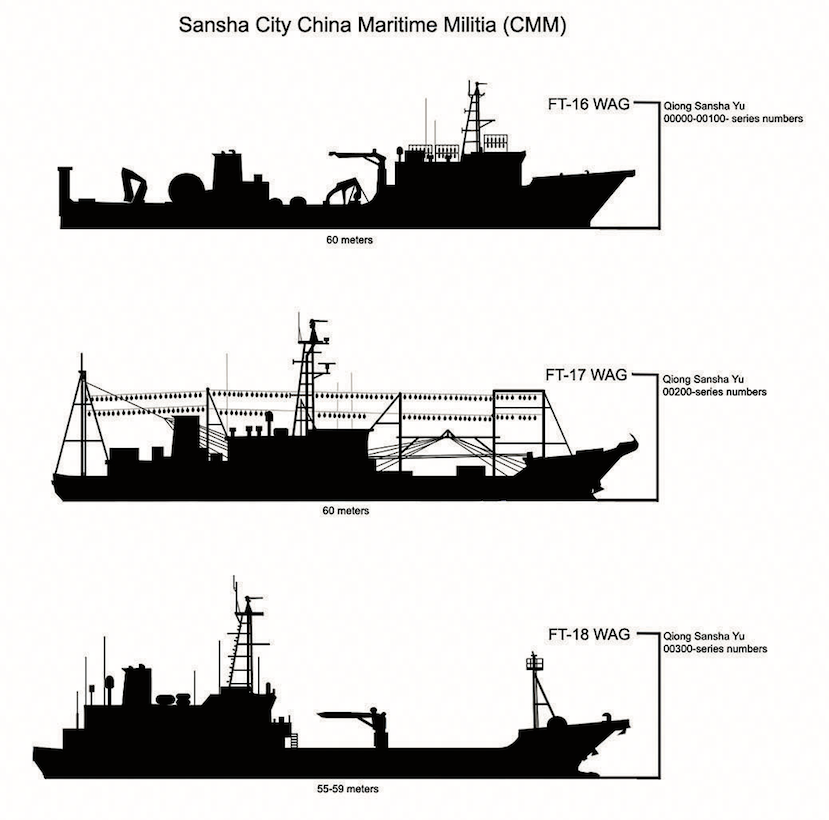
Three types of maritime militia vessels depicted in the Office of Naval Intelligence’s China’s People’s Liberation Army Navy (PLAN), Coast Guard, and Government Maritime Forces 2018 Recognition and Identification Guide. (Office of Naval Intelligence)
There are no solid numbers publicly available on the size of China’s maritime militia, but it is clearly the world’s largest. In fact, it is virtually the only one charged with involvement in sovereignty disputes: only Vietnam, one of the very last countries politically and bureaucratically similar to China, is known to have a similar force with a similar mission. China’s maritime militia draws on the world’s largest fishing fleet, incorporating through formal registration a portion of its thousands of fishing vessels, and the thousands of people who work aboard them as well as in other marine industries. The PAFMM thus recruits from the world’s largest fishing industry. According to China’s 2016 Fisheries Yearbook, China’s fishing industry employs 20,169,600 workers, mostly in traditional fishing practices, industry processing, and coastal aquaculture. Those who actually fish “on the water” number 1,753,618. They operate 187,200 “marine fishing vessels.” An unknown portion of these are militia boats. To give a sense of the size and distribution of PAFMM forces, our volume includes figures showing the location of leading militia units in two major maritime provinces: Hainan and Zhejiang.
Q: How is the CCG organized for gray zone operations?
Martinson: When we held the conference in 2017, the CCG was in the midst of a major organizational reform. It was only set up in 2013, the result of a decision to combine four different maritime law enforcement agencies. Before 2013, most rights protection operations were conducted by two civilian agencies: China Marine Surveillance and Fisheries Law Enforcement. They did not cooperate well with each other. Moreover, neither had any real policing powers. After the CCG was created, it became clear that Beijing intended to transform it into a military organization. In early 2018, Beijing announced a decision to transfer the CCG from the State Oceanic Administration to the People’s Armed Police. At about the same time, the People’s Armed Police was placed under the control of the Central Military Commission. So, like the PAFMM, it is now a component of China’s armed forces. Moreover, CCG officers now have the authority to detain and charge foreign mariners for criminal offenses simply for being present in disputed areas of the East China Sea and South China Sea (although they have yet to use this authority in practice).
Q: How is the CCG equipped to assert China’s maritime claims?
Martinson: When Beijing’s gray zone campaign began in earnest in 2006, China’s maritime law enforcement forces were fairly weak. They owned few oceangoing cutters, and many of those that they did own were elderly vessels handed down from the PLA Navy or the country’s oceanographic research fleet. They were not purpose-built for “rights protection” missions. In recent years, however, Beijing has invested heavily in new platforms for the CCG. Today, China has by far the world’s largest coast guard, operating more maritime law enforcement vessels than the coast guards of all its regional neighbors combined. As the chapter by Joshua Hickey, Andrew Erickson, and Henry Holst points out, the CCG owns more than 220 ships over 500 tons, far surpassing Japan (with around 80 coast guard hulls over 500 tons), the United States (with around 50), and South Korea (with around 45). At over 10,000 tons full load, the CCG’s two Zhaotou-class patrol ships are the world’s largest coast guard vessels. The authors project that in 2020 China’s coast guard could have 260 ships capable of operating offshore (i.e., larger than 500 tons). Drawing from lessons learned while operating in disputed areas in the East and South China Seas, recent classes of Chinese coast guard vessels have seen major qualitative improvements. They are larger, faster, more maneuverable, and have enhanced firepower. Many CCG vessels are now armed with 30 mm and 76 mm cannons.
Q: It appears that these gray zone forces and operations are heavily focused on sovereignty disputes such as in the East and South China Seas. Are they also pursuing other goals and lines of effort?
Erickson: That is correct. The vast majority of maritime gray zone activities involve efforts to assert Chinese control and influence over disputed maritime space in what Chinese strategists term the “Near Seas.” When conducting rights protection operations, these forces help Beijing enforce its policies regarding which kinds of activities can and cannot take place in Chinese-claimed areas. The CCG and PAFMM intimidate and harass foreign civilians attempting to use the ocean for economic purposes, such as fishing and oil/gas development. Since at least 2011, for instance, China’s coast guard and militia forces have been charged with preventing Vietnam from developing offshore hydrocarbon reserves in its own Exclusive Economic Zone (EEZ), part of which overlaps with China’s sweeping nine-dash line claim. China’s gray zone forces also protect Chinese civilians operating “legally” in Chinese-claimed maritime space. The 2014 defense of Chinese drilling rig HYSY-981, discussed in detail in our volume, is a classic case of this type of gray zone operation. By controlling maritime space, China’s gray zone forces can also determine who can and cannot access disputed features. Since 2012, for instance, Chinese coast guard and militia forces have upheld Chinese control over Scarborough Reef. Today, Filipino fishermen can only operate there with China’s permission.
Q: What are some of the tactics employed by China’s gray zone forces?
Erickson: Most CCG cutters are unarmed, and PAFMM vessels are minimally armed at most. They assert Chinese prerogatives through employment of a range of nonlethal tactics. In many cases, Chinese gray zone ships are themselves the weapon: they bump, ram, and physically obstruct the moments of other vessels. They also employ powerful water cannons to damage sensitive equipment aboard foreign ships and flood their power plants. Foreign states are often helpless to respond because China has the region’s most powerful navy, which gives it escalation dominance.
Q: How have regional states reacted to Chinese maritime gray zone operations? Have some had more effective responses than others?
Martinson: Regional states have not presented China with a united front. They have each handled Chinese encroachments differently. China’s strongest neighboring sea power, Japan has taken the most vigorous actions. As Adam Liff outlines in his chapter, it has bolstered its naval and coast guard forces along its southern islands. It has also taken bold steps to publicize China’s gray zone actions. Vietnam has been a model of pushback against Beijing’s maritime expansion, as Bernard Moreland recounts in his chapter. But even its resistance has limits. In July 2017, Beijing likely used gray zone forces to compel Hanoi to cancel plans to develop oil and gas in its own EEZ, in cooperation with a Spanish company. Other states have taken a much more conciliatory approach to China’s incursions in the South China Sea. The Philippines, for example, is apparently acquiescing to Beijing’s desire to jointly develop disputed parts of the South China Sea—areas that a 2016 arbitration ruling clearly place under Philippine jurisdiction. Meanwhile, China continues to push Manila in other ways. Philippine supply shipments to Second Thomas Shoal are still subject to harassment. China has recently concentrated a fleet of gray zone forces just off the coast of Philippine-occupied Thitu Island, in an apparent effort to pressure Manila to discontinue long-planned repairs and updates to its facilities there.
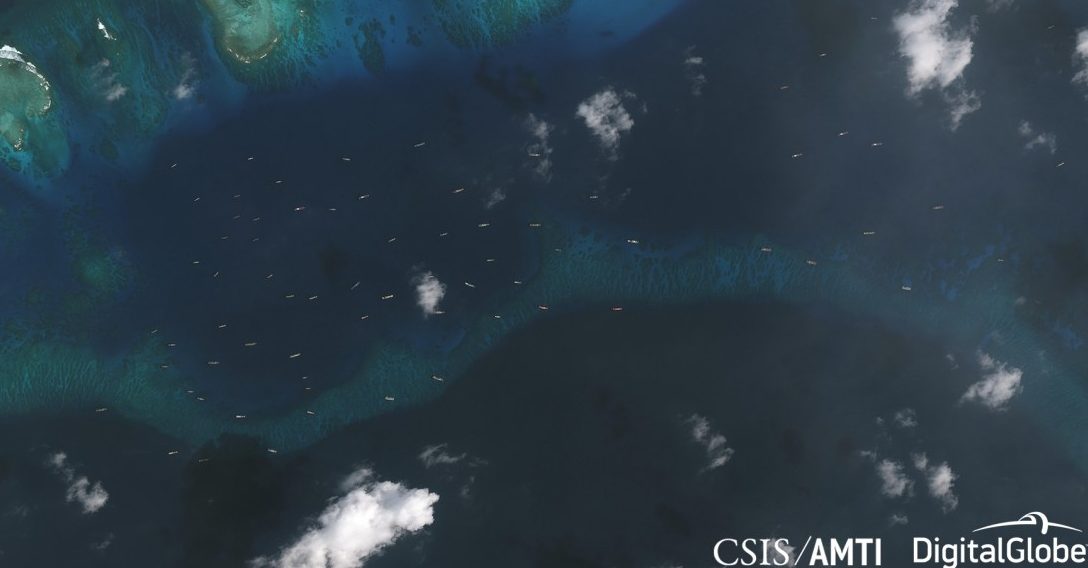
Chinese fishing vessels massed off Philippine-occupied Thitu Island in January 2019. (CSIS/AMTI, DigitalGlobe)
At the same time, China itself continues to develop reclaimed land at Mischief Reef, a mostly submerged feature which because of its location clearly belongs to the Philippines. For its part, Malaysia has not publicly opposed Chinese incursions in its jurisdictional waters. But it is apparently proceeding with plans to develop seabed resources near the Chinese-claimed Luconia Shoals. Chinese coast guard vessels patrol the area, but have not forced a cessation of exploratory drilling operations—including those conducted by the Japanese-owned drilling rig Hakuryu 5 in February 2018. This story will be worth following, as Malaysia makes decisions about next steps. In 2016, Indonesia took robust actions to crack down on Chinese fishing activities near the southern part of the nine-dash line, northeast of its Natuna Islands. Things have been fairly quiet in the years since, perhaps because CCG vessels are escorting the fishing fleet to the area.
Q: It seems like China’s gray zone strategy is more often directed at other countries. Why is this topic important for U.S. national security?
Erickson: The U.S. Navy has also been targeted by China’s gray zone forces. U.S. Navy special mission ships such as the USNSBowditch, USNS Impeccable, USNS Effective, USNS Victorious, and USNS Howard O. Lorenzen have been shadowed and harassed, victims of China’s erratically-enforced opposition to foreign naval activities within its claimed EEZ. To be sure, China’s gray zone campaign is largely targeted at other territorial claimants, but two of these countries—Japan and the Philippines—are U.S. allies. Washington’s robust alliance with Tokyo, in particular, is critical to American presence and peace preservation in a vital but vulnerable region. Chinese bullying behavior threatens to undermine these alliances and could trigger direct American military intervention if China’s gray zone operations were to escalate into armed attack. Moreover, as Jonathan Odom points out in his chapter, China’s activities violate important international conventions and norms. This means they are weakening key pillars of the international maritime order, and with it the global system on which peace and prosperity depend. In many cases China’s gray zone forces are used to assert maritime claims that have no basis in international law.
Q: And how can the U.S. Navy, as a more high-end force, better handle these sorts of Chinese paramilitary forces without risking escalation?
Martinson: If the United States wants to be effectual, it must do more to expose China’s gray zone activities, and it must accept a degree of risk in opposing them more strongly. China’s gray zone activities cannot be easily deterred, because each individual act is calculated to fall below American red lines. If Washington wants to get serious about countering China’s gray zone expansion, it must do more than conduct “presence” and “freedom of navigation” operations—which appear to sit at the heart of the current approach. The former cannot deter Beijing from taking tactical actions in the gray zone. The latter does little to defend the interests of allies and partners. In our concluding chapter, we suggest ways that the U.S. Navy can do more to help them protect their legitimate interests and defend the legal norms and conventions that China’s behavior threatens to erode. In short, the United States should be out there with them, operating on the front lines of China’s seaward expansion. To that end, it must develop a range of nonlethal tactics that it can use to achieve local effects without resorting to use of force.
Dr. Andrew S. Erickson is a Professor of Strategy in the China Maritime Studies Institute and the recipient of the inauguralCivilian Faculty Research Excellence Award at the Naval War College. He is an Associate in Research at Harvard University’s John King Fairbank Center for Chinese Studies and a member of the Council on Foreign Relations. In 2013, while deployed in the Pacific as a Regional Security Education Program scholar aboard USS Nimitz, he delivered twenty-five hours of presentations. Erickson is the author of Chinese Anti-Ship Ballistic Missile Development (Jamestown Foundation/Brookings Institution Press, 2013). He received his Ph.D. from Princeton University. Erickson blogs at www.andrewerickson.com.
Ryan D. Martinson is a researcher in the China Maritime Studies Institute at the U.S. Naval War College. He holds a master’s degree from the Fletcher School of Law and Diplomacy at Tufts University and a bachelor’s of science from Union College. Martinson has also studied at Fudan University, the Beijing Language and Culture University, and the Hopkins-Nanjing Center. The views expressed are those of the authors and do not reflect the official policy or position of the U.S. Navy, the Department of Defense, or the U.S. Government.
Featured Image: A China Coast Guard ship uses a water cannon to harass a Vietnamese law enforcement vessel near the disputed Paracel Islands on May 27, 2014. (Photo by The Asahi Shimbun)
BACKGROUND AND SUMMARY OF VOLUME, AS WELL AS EDITORS’ FURTHER ANALYSIS AND POLICY RECOMMENDATIONS:
Ryan D. Martinson and Andrew S. Erickson, “Re-Orienting American Sea Power for the China Challenge,” War on the Rocks, 10 May 2018.
Summary: this article proposes a new set of tools for countering China’s maritime gray zone expansion.
As a seafaring state, America demands maximal access to the world’s oceans within the constraints of international law. Though seldom recognized, U.S. efforts to defend its interest in maritime freedom in the Western Pacific have been fairly successful. When the People’s Republic of China unlawfully draws “fences” around the sea, U.S. warships steam through the fences. Beijing recognizes the seriousness of America’s position, and thus far has generally yielded.
However, when it comes to helping its allies and partners protect themselves against Chinese encroachment, the United States has a mixed record. Since 2006, Beijing has dramatically expanded the frontiers of its control in the East and South China Seas. To pursue its irredentist agenda, Beijing has largely relied on unarmed or lightly armed paranaval forces — coast guard and militia — conducting operations in what has been described as the “gray zone” between war and peace. Despite the robust presence of American sea power in contested areas of maritime East Asia, the United States has largely failed to halt China’s bullying behavior. This failure devalues Washington’s commitments to its friends and shakes the foundations of the U.S. alliance system — the true source of American global influence.
To better aid its allies and partners, Washington should consider expanding its catalogue of peacetime maritime operations. Passive presence has proved inadequate. In some cases, American policymakers may need to place U.S. forces on the front lines, where they can play a more direct role helping other states counter China’s seaward expansion. … …
